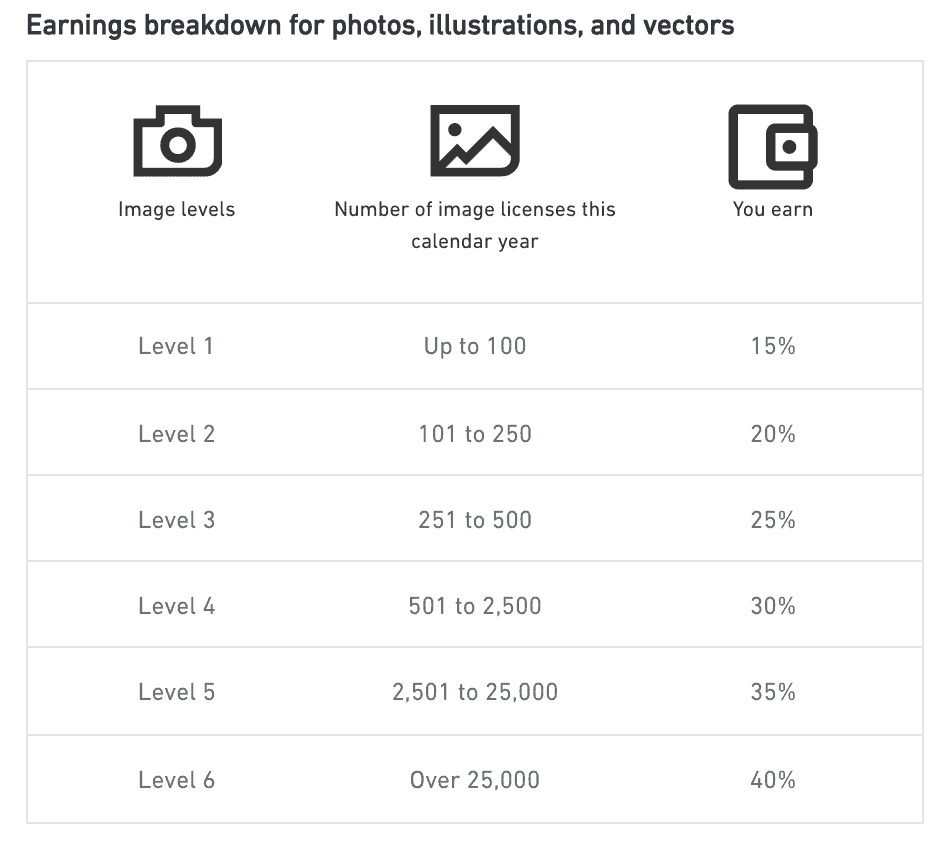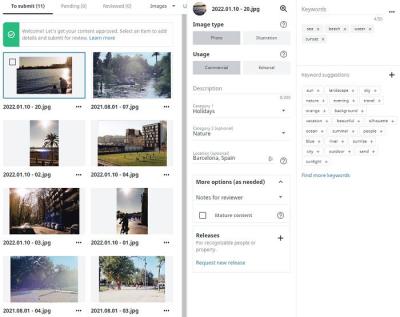If you’re passionate about photography and thinking about turning that passion into a source of income, Shutterstock might be on your radar. As one of the largest stock photo platforms out there, Shutterstock offers photographers and artists the chance to earn money whenever their images are downloaded. But how exactly does the payment system work? And how much can you expect to make? That’s what we’re diving into today. Understanding how
Factors That Influence Shutterstock Contributor Earnings

Your earnings on Shutterstock aren’t set in stone—they depend on several factors. Knowing what impacts your income can help you optimize your portfolio and submission strategies. Here are the main elements that influence how much Shutterstock pays contributors:
- Contributor Level: Shutterstock awards different commission rates based on your contributor level, which is determined by your total earnings and portfolio quality. New contributors start at a basic level and can move up as they gain more downloads and maintain quality standards. Higher levels come with higher royalty rates.
- Subscription vs. On-Demand Purchases: Shutterstock offers two main types of sales: subscriptions and individual image purchases. Typically, subscription downloads generate lower royalties per image but can lead to a higher volume of sales. On-demand or single-image purchases tend to pay higher royalties per download, balancing out the total earnings.
- Download Volume: The more your images are downloaded, the more you earn. Building a diverse, high-quality portfolio that appeals to a broad audience can boost your download count and, consequently, your earnings.
- Image Quality and Relevance: Shutterstock has strict quality standards. Uploading high-resolution images with good composition, lighting, and relevance increases your chances of acceptance and more downloads, leading to better earnings.
- Keyword Optimization: Properly tagging and keywording your images helps potential buyers find your work. Well-optimized images are more likely to be discovered, increasing download opportunities and earnings.
- Exclusive vs. Non-Exclusive Contributions: Shutterstock allows contributors to be exclusive or non-exclusive. Exclusive contributors typically earn higher royalty rates but agree to sell only through Shutterstock. Non-exclusive contributors can sell elsewhere, but their earnings per download might be slightly lower.
In summary, your earnings depend on a mix of your contributor level, sales type, image quality, and how well you market your work through keywords. Staying consistent, improving your skills, and understanding Shutterstock’s payment structure can help you grow your income over time. Remember, building a successful stock photography portfolio is a marathon, not a sprint—patience and persistence pay off!
How Shutterstock Revenue Sharing Works for Photographers
So, you’re curious about how photographers actually make money on Shutterstock? Let’s break it down. Shutterstock operates on a revenue-sharing model, which means that when someone downloads your photo, you get a portion of the fee paid by the customer. Think of it as a pie: the company takes a slice to cover its costs, and the rest goes to the contributor.
Here’s the core idea: Shutterstock has a set licensing fee for each download, and this fee can vary depending on the subscription plan or on-demand purchase. When a customer downloads your photo, Shutterstock calculates your earnings based on your contributor level and the type of license purchased. They then pay you a percentage of the total fee, which is called your royalty rate.
But it’s not a flat rate across the board. Instead, Shutterstock uses a tiered royalty system. As you upload more photos and earn more, your royalty percentage increases. This means that the more popular and higher-quality your images are, the more you stand to earn per download.
Another important aspect is the exclusive vs. non-exclusive status. Exclusive contributors agree to sell only their photos through Shutterstock, and in return, they typically earn higher royalty rates — often starting around 30-40%. Non-exclusive contributors, who sell their photos on multiple platforms, usually receive a lower percentage, around 15-20%. So, if you’re serious about maximizing earnings, going exclusive can be a good move.
In short, Shutterstock’s revenue sharing is designed to reward active, high-quality contributors with higher earnings per download. It’s all about building a portfolio, increasing your download count, and climbing the contributor tiers. Keep producing great images, and the payout can add up over time!
Average Earnings per Photo and Payment Tiers
Now, let’s talk numbers. How much can you really expect to earn per photo on Shutterstock? Well, it varies widely depending on several factors like your contributor level, the type of license, and your exclusivity status. But to give you a ballpark, here’s what most contributors see:
| Contributor Level | Average Earnings per Download | Typical Royalty Rate |
|---|---|---|
| Standard | $0.25 – $0.45 | 15-30% |
| Advanced | $0.45 – $1.00 | 30-40% |
| Elite | $1.00+ | 40% or more |
As you climb the contributor tiers—starting from Standard and moving up to Elite—the average earnings per download tend to increase. That’s because your royalty rate goes up, and your photos are often featured more prominently, leading to more downloads.
It’s also worth noting that the actual earnings per photo depend on the licensing type:
- Standard License: suitable for most uses, typically yields lower earnings.
- Enhanced License: for high-volume or high-visibility uses, with higher payout potential.
While earning $1 or more per download might not sound huge, remember that many photos get dozens or even hundreds of downloads over time. Consistency, quality, and a diverse portfolio can turn your Shutterstock account into a steady income stream.
Finally, don’t forget about the payout thresholds. Shutterstock pays contributors via PayPal or Skrill once your earnings reach $35. So, keep uploading, and watch your earnings grow toward that payout threshold!
Tips to Increase Your Shutterstock Photography Income
So, you’re eager to boost your earnings as a Shutterstock contributor — that’s fantastic! The good news is, there are several practical strategies you can implement to maximize your income potential. Let’s dive into some tried-and-true tips that can help you stand out and earn more from your beautiful photos.
1. Focus on High-Demand Topics
Start by researching what buyers are looking for. Popular categories like business, technology, health, lifestyle, and seasonal themes tend to attract more downloads. Keep an eye on trending topics or current events, and consider creating images that are relevant and timely. The more your images align with what buyers want, the higher your chances of earning royalties.
2. Upload Consistently and in Batches
Regular uploads help keep your portfolio fresh and increase visibility. Instead of uploading a few images sporadically, try batching your submissions — this way, your portfolio stays active and diverse, appealing to a wider range of buyers. Consistency can also boost your chances of being featured or recommended by Shutterstock’s algorithm.
3. Invest in Quality and Uniqueness
Quality always trumps quantity. Use good equipment, pay attention to lighting, composition, and editing to create sharp, compelling images. Unique perspectives or niche subjects can also help you stand out from the crowd. Remember, buyers are often looking for something fresh and different!
4. Optimize Your Metadata
Great images won’t sell if they’re hard to find. Make sure to add accurate, descriptive titles, keywords, and categories. Think about what words a buyer might use to search for your image. The more precise your metadata, the higher the chances your photos will appear in search results, leading to more downloads and royalties.
5. Participate in Shutterstock Contributor Challenges and Promotions
Shutterstock often runs contests or promotions that can give your work extra exposure. Participating in these can lead to increased visibility and, potentially, higher earnings if your images get featured or win prizes. Keep an eye on the Contributor Dashboard for opportunities to showcase your best work.
6. Diversify Your Portfolio
Don’t put all your eggs in one basket. Upload a variety of images — different themes, styles, and formats. This not only appeals to a broader audience but also reduces risk if certain categories become less popular over time. A diverse portfolio can lead to steady, ongoing income streams.
Conclusion and Final Thoughts on Shutterstock Contributor Payments
Understanding how much Shutterstock pays contributors is an essential step toward building a successful photography side hustle or career. While the royalty rates might seem modest at first glance, they can add up over time, especially if your images are popular and frequently downloaded. Remember, your earnings depend on several factors — your exclusive status, the quality of your images, their relevance, and how well you optimize your metadata.
By implementing strategic tips like focusing on high-demand topics, maintaining quality, and staying consistent, you can significantly increase your income potential. Patience and persistence are key; building a thriving portfolio takes time, but with dedication, you can turn your passion for photography into a reliable income stream.
Keep experimenting, stay updated with Shutterstock’s policies and trends, and most importantly, enjoy the creative process. Every upload is a step toward earning more and sharing your unique perspective with the world. Happy shooting!


